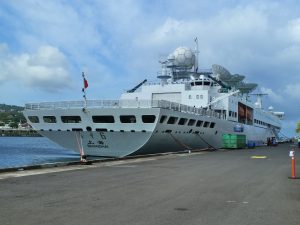A Chinese “research and survey” vessel that is heading to Hambantota Port in southern Sri Lanka could roil India-Sri Lanka relations again.
On July 30, Sri Lanka’s Ministry of Defense spokesperson Col. Nalin Herath told reporters at a press conference in Colombo that “the vessel will be in Hambantota from August 11 to 17, mainly for replenishment, including fuel.” “Such vessels periodically come from various countries such as India, China, Japan, Australia,” Herath said, adding that “it is nothing unusual.”
Only days earlier, the defense ministry had denied reports of the Chinese vessel’s impending arrival at the island.
The ship in question is the Yuan Wang 5, a “Chinese scientific research vessel” that “will conduct satellite control and research tracking in the north western part of the Indian Ocean region,” Indian television news channel Times Now reported on July 23.
A few days later, India’s Ministry of External Affairs (MEA) spokesperson Arindam Bagchi said that India is “aware of reports of a proposed visit by this vessel at Hambantota port, in August.” The “government carefully monitors any development having a bearing on India’s security and economic interests and takes all necessary measures to safeguard them,” he said, adding that this “should be a clear message.”
Although Bagchi made no reference to the Chinese, Beijing snapped back swiftly, saying it hoped that “relevant parties” would refrain from interfering with its “legitimate maritime activities.”
Reports in the Indian media have drawn attention to the security implications of the Chinese ship’s visit to Sri Lanka. While CNN-News18 has pointed out that the Yuan Wang 5 is a “dual-use spy vessel, employed for space and satellite tracking and with specific usage in intercontinental ballistic missile launches,” Economic Times noted that with the vessel boasting an aerial reach of 750 km, India’s nuclear power stations at Kalpakkam and Koodankulam as well as six ports in southern India are in danger of being “snooped upon.”
On Tuesday, Sri Lanka sought to allay Indian apprehensions over the Chinese ship’s docking at Hambantota. “It is coming to refuel and not for any other purpose,” cabinet spokesperson Bandula Gunawardena told reporters in Colombo.
That is unlikely to smooth ruffled feathers in New Delhi.
The rising Chinese presence in Sri Lanka over the past decade has been a matter of serious concern to India.
Indian analysts had warned that China’s influence over Sri Lankan leaders and its grip over the economy would force Sri Lanka into a debt trap, paving the way for a Chinese military presence on the island. In 2018, Sri Lanka handed over the Chinese-constructed Hambantota Port to Beijing in lieu of unpaid loans, triggering alarm in New Delhi over the possible military use of the port by the Chinese.
Although Sri Lanka assured India that Hambantota would not be used by the Chinese for military purposes, Indian apprehensions have persisted especially since Colombo has not always shown sensitivity to Indian security concerns relating to China.
In 2014, for instance, the Sri Lankan government permitted the docking of a Chinese nuclear submarine and a warship at Colombo port ignoring India’s protests.
Over the last couple of years, India’s efforts to push back Chinese influence in Sri Lanka had begun to bear fruit. With New Delhi taking the lead in extending lines of credit and humanitarian assistance to Sri Lanka during the current economic crisis – it has given the island around $3-4 billion this year, and the pro-China Rajapaksas ousted from power, it did seem that India had recovered lost influence in the island.
Sri Lanka’s permission for the Yuan Wang 5 to dock at Hambantota indicates that while India may have gained some public goodwill over the past few months, Sri Lanka’s decision-makers remain in China’s grip. It could also mean that when it comes to the Hambantota Port, Sri Lanka has little say on who visits or for what purpose.
By sending in a dual-purpose ship to dock at Hambantota Port amid the crisis in Sri Lanka, China has sent out the message that its control over the strategic Hambantota Port remains strong.
The docking of Chinese naval vessels at Colombo in 2014 set in motion a fraying in India’s relations with the then President Mahinda Rajapaksa, culminating in his defeat in presidential elections the following year.
India’s response to the upcoming docking of the Chinese ship may not be as severe. But it will impact New Delhi’s support to Colombo in the coming months.

































